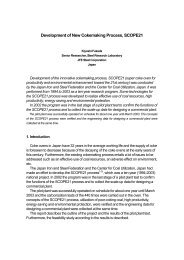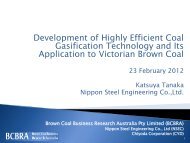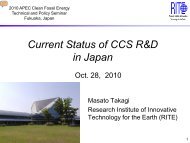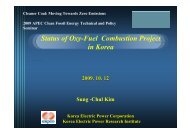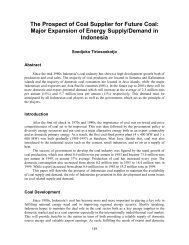Defining CCS Ready: An Approach to An International Definition
Defining CCS Ready: An Approach to An International Definition
Defining CCS Ready: An Approach to An International Definition
- No tags were found...
You also want an ePaper? Increase the reach of your titles
YUMPU automatically turns print PDFs into web optimized ePapers that Google loves.
C.3 Frameworks for Economic <strong>An</strong>alysesAppendix C: Policy Considerations and Assessments of <strong>CCS</strong> <strong>Ready</strong> EconomicsThe framework for an economic analysis is the method used <strong>to</strong> combine costs and benefitsin<strong>to</strong> indica<strong>to</strong>rs of relative economic value. Some of the options for frameworks that can beused by policymakers or developers for economic analysis of <strong>CCS</strong> <strong>Ready</strong> plants include (inincreasing order of complexity and accuracy):1) A very simple comparison of the added capital costs for the new <strong>CCS</strong> <strong>Ready</strong> plantversus the future capital cost savings if a “Not <strong>CCS</strong> <strong>Ready</strong>” (i.e., BAU) plant was laterconverted <strong>to</strong> <strong>CCS</strong>. This technique can serve as a simple and easy-<strong>to</strong>-use screening <strong>to</strong>ol<strong>to</strong> show a) how much higher the <strong>CCS</strong> <strong>Ready</strong> plant’s initial capital costs are versus theBAU plant and b) how much the savings will be in capital for a future retrofit. Thiscomparison would ignore any operating cost savings, the time value of money, andwhether future retrofit <strong>to</strong> <strong>CCS</strong> will be economical. See <strong>to</strong>p part of Exhibit C-1 for anillustration using the same assumptions as will be described later in this chapter for theMonte Carlo example.2) A comparison of the added capital costs for the new <strong>CCS</strong> <strong>Ready</strong> plant versus the futurecapital cost and gains in net operating revenue if a BAU plant were later converted <strong>to</strong><strong>CCS</strong>. This comparison could assume, for example, that there are 25 years of operatingcost savings, but it still ignores the time value of money or whether a <strong>CCS</strong> retrofit willbe economic. This <strong>to</strong>o can be used as an initial screening <strong>to</strong>ol.3) Same as #2 but taking in<strong>to</strong> account the time value of money by discounting the financialcosts and gains based on how many years in<strong>to</strong> the future they occur. This is the mostsophisticated of the simple screening <strong>to</strong>ols but is the minimum that should be employedfor decision making since it is critical that the time value of money be taken in<strong>to</strong>consideration. This framework is illustrated in the bot<strong>to</strong>m part of Exhibit C-1, whichshows that <strong>CCS</strong> <strong>Ready</strong> designs 1 and 2 appear <strong>to</strong> be economics under the assumptionsused for the illustration, but that <strong>CCS</strong> <strong>Ready</strong> design 3 is not economic.4) Same as #3, but instead of assuming when retrofits <strong>to</strong> <strong>CCS</strong> take place and the number ofyears of operation of <strong>CCS</strong>, looks at each year of operation and determines theeconomics of a decision <strong>to</strong> convert <strong>to</strong> <strong>CCS</strong> given a projection of GHG allowance cos<strong>to</strong>r other value of reduced emissions and assumptions for energy prices. If appropriatefor the market conditions in a jurisdiction, this framework would also take in<strong>to</strong> accounthow the dispatch of the plant would change. If conversion <strong>to</strong> <strong>CCS</strong> seems <strong>to</strong> be far fromever being economic (or not be otherwise incentivised or mandated), there will be littlejustification for <strong>CCS</strong> <strong>Ready</strong>. The Monte Carlo example <strong>to</strong> be shown later in this chapteremploys a variant of Framework 4.23 February 2010 104




